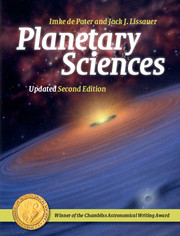Book contents
- Frontmatter
- Contents
- List of Tables
- Preface
- 1 Introduction
- 2 Dynamics
- 3 Solar Heating and Energy Transport
- 4 Planetary Atmospheres
- 5 Planetary Surfaces
- 6 Planetary Interiors
- 7 Magnetic Fields and Plasmas
- 8 Meteorites
- 9 Minor Planets
- 10 Comets
- 11 Planetary Rings
- 12 Extrasolar Planets
- 13 Planet Formation
- Appendix A List of Symbols Used
- Appendix B Acronyms Used
- Appendix C Units and Constants
- Appendix D Periodic Table of Elements
- Appendix E Observing Techniques
- Appendix F Interplanetary Spacecraft
- Appendix G Recent Developments in Planetary Sciences
- References
- Index
- Plate Section
- References
10 - Comets
Published online by Cambridge University Press: 05 January 2015
- Frontmatter
- Contents
- List of Tables
- Preface
- 1 Introduction
- 2 Dynamics
- 3 Solar Heating and Energy Transport
- 4 Planetary Atmospheres
- 5 Planetary Surfaces
- 6 Planetary Interiors
- 7 Magnetic Fields and Plasmas
- 8 Meteorites
- 9 Minor Planets
- 10 Comets
- 11 Planetary Rings
- 12 Extrasolar Planets
- 13 Planet Formation
- Appendix A List of Symbols Used
- Appendix B Acronyms Used
- Appendix C Units and Constants
- Appendix D Periodic Table of Elements
- Appendix E Observing Techniques
- Appendix F Interplanetary Spacecraft
- Appendix G Recent Developments in Planetary Sciences
- References
- Index
- Plate Section
- References
Summary
You see therefore an agreement of all the Elements in these three, which would be next to a miracle if they were three different Comets … Wherefore, if according to what we have already said it should return again about the year 1758, candid posterity will not refuse to acknowledge that this was first discovered by an Englishman.
Edmond Halley, 1752, Astronomical Tables, LondonThe generally unexpected and sometimes spectacular appearances of comets have triggered the interest of many people throughout history. A bright comet can easily be seen with the naked eye, and its tail can extend more than 45° on the sky (Fig. 10.1). The name comet is derived from the Greek word κωμητηζ which means ‘the hairy one’, describing a comet's most prominent feature: its long tail. The earliest records of comets date back to ∼6000 bce in China. In the time of Pythagoras (550 bce) comets were considered to be wandering planets, but Aristotle (330 bce) and subsequent natural philosophers thought comets were some kind of atmospheric phenomenon. Comets were therefore scary, and often considered bad omens. An apparition of Comet 1P/Halley is depicted on the Bayeux Tapestry (Fig. 10.2), which commemorates the Norman conquest of England in 1066.
The first detailed scientific observations of comets were made by Tycho Brahe in 1577. Brahe determined that the parallax of the bright Comet C/1577 VI was smaller than 15 arcminutes, and concluded that therefore the comet must be further away than the Moon. Edmond Halley used Newton's gravitational theory to compute parabolic orbits of 24 comets observed up to 1698. He noted that the comet apparitions in 1531, 1607, and 1682 were separated by 75–76 years, and that the orbits were described by roughly the same parameters. He hence predicted the next apparition to be in 1758. It was noticed much later that this Comet Halley, as it was named subsequently, has returned 30 times from 240 bce to 1986; records of all of these apparitions have been found with the exception of 164 bce.
Information
- Type
- Chapter
- Information
- Planetary Sciences , pp. 405 - 447Publisher: Cambridge University PressPrint publication year: 2015
